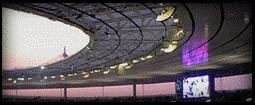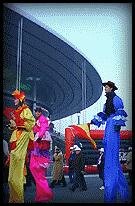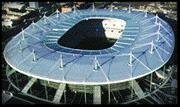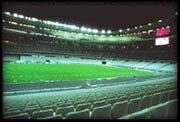 |
The STADE DE FRANCE
|
| |
 |
|

|
i |
|
|

|
|
The FRANCE 98 Football World Cup was the force that generated it, and now the Stade de France can only be described in superlatives: the biggest multi-function Olympic-sized stadium in the world; the biggest worksite in France, and the one that has received the most media attention. From day one in May 1995 when building work started, the site, due for completion in November 1997, has never failed to astonish its visitors. It has to be said that over and above its technical achievements, the stadium, conceived by the Bouygues, GTM-Entrepose and SGE Groups, and designed by the architects Macary, ZublÚna, Regembal and Costantini, is impressive for many other reasons!
|

|
|
|
|
 |
|
 |
| |
 |
The Stade de France figures
|
 |
| Location: |
North of Paris, 10 km from Notre-Dame |
| First inaugurated: |
28 January, 1998. France - Spain (friendly) |
| Variable capacity: |
Thanks to its variable capacity, its unparalleled comfort, and the exceptional quality of its installations, the Stade de France can host a wide variety of events ranging from football and rugby matches to shows on a grand scale, as well as athletics competitions.
The ability to vary its capacity is one of the Stade de France's chief assets. The circle of mobile stands closest to the sports area, and which contain 25,000 seats, is an amazing technical achievement, for never before has flexibility on this scale been attempted. The stands, when set in a configuration 15 metres back from the running tracks and the jumping pits, provides 21,000 seats, giving spectators maximum visibility. The middle stand has a capacity of 30,000, and the upper stand 25,000. In addition, the stadium ground itself can accommodate 25,000, bringing the maximum capacity for large-scale shows to 105,000.
|
Comfort for
everybody: |
Everything has been designed with the comfort of each spectator in mind: the public has easy access to covered seats thanks to a special compartmentalised system in the stands, which leads directly to the esplanade. The elliptical form of the stands was chosen to enable the best possible view of the games area, while their actual design, "hugging" the curve of the race track, has long been recognised as the most effective for an Olympic stadium. The comfort of the sportsmen and women was also a prime concern for the architects, as well as those for the media, who will find in the Stade de France the best possible working conditions.
But for the moment, the 16th Football World Cup is the driving force behind the giant structure. And if you close your eyes, you can already hear the clamour rising from the stadium, this clamour that will be thrilling the whole world throughout the summer of 1998 !
|
|
 |
|
 |
| |
 |
ALTERATIONS
|
 |
| Consortium : |
Bouygues - GTM-Entrepose - SGE |
| Architects : |
Macary-ZublÚna-Regembal-Costantini |
|
|

|
|

|
 |
|
 |
|
| |
 |
|
i
|
 |

|

|
i |
|
|
 |
 |
| |
 |

|
 |
|
|
 |
 |
| |
 |

|
 |
|
|
 |
 |
| |
 |

|
 |
|
|
 |
 |
|
Photos SAOLA
|
 |
STADE DE FRANCE:
No. 10's No. 1
|
 |
|
It was well worth the sixty-year wait, because the Stade de France, now rising proudly in Paris' northern suburb, Saint-Denis, is "the handsomest stadium in the world," according to Joao Havelange. For the inauguration the French Football Federation organised a game between France and Spain, a particularly intriguing friendly match as both teams figure among the favourites to win the forthcoming World Cup.
On 28 January 1998, 80,000 enthusiastic spectators were on hand, despite the bitter cold (-6 ░), to see Zinedine Zidane score the first goal in the stadium's history in a thoroughly deserved 1-0 victory for France. A few days later, another 80,000-strong crowd cheered the French rugby team to a superb victory over England (24-17). Auspicious beginnings for this "monument," where on 12 July the winners of the 16th World Cup will be crowned.
|
|
 |
|
 |
| |
 |
 |
|
|
|
|